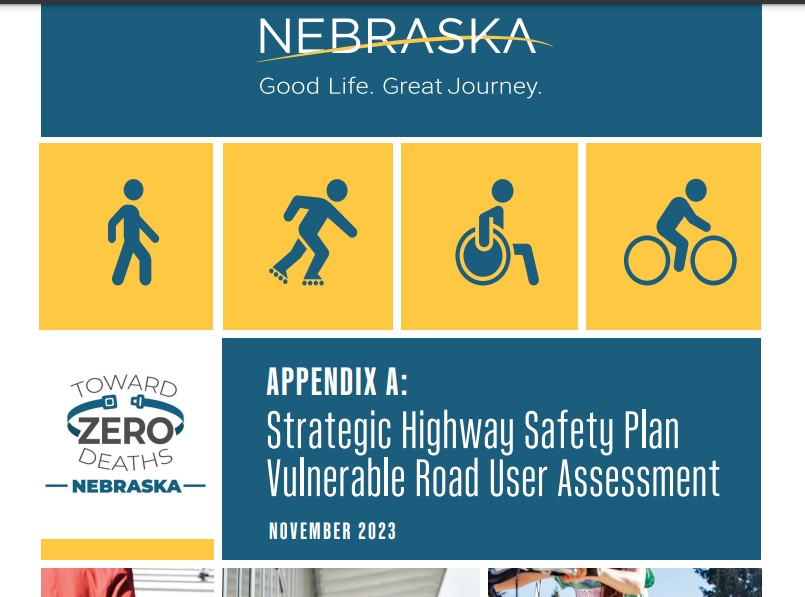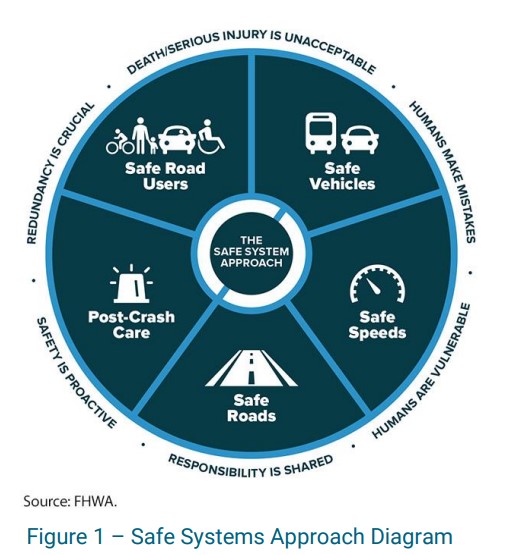Last week, an updated version of the Strategic Highway Safety Plan was released. Monday’s Omaha World Herald (11/27/23) included an article by Martha Stoddard that brings attention to a shift in the Nebraska Department Of Safety’s view towards vulnerable road users, VRU’s for short.
The new safety plan gets into the weeds with data analysis. Pages 59 through 89 of the new safety plan consist of Appendix A, the vulnerable road user assessment.
Here are a few nuggets: “The assessment provides further insight to trends of VRU crashes as compared to overall crashes, provides greater specificity as to areas with the greatest opportunities for improvement, and identifies strategies to reduce fatalities and serious injuries for VRU.”

Also, “The SHSP discusses crashes involving VRUs on page 32 and 33 and identified six strategies for improving VRU safety.
- High Visibility Crosswalk Markings
- Rectangular Rapid Flashing Beacons
- Roundabouts
- Road Diets
- ADA Ramps & Curb Extensions
- Crosswalk Overhead Lighting”
These strategies force motorists to lower speeds and be more observant of others.
In it’s conclusion, the safety plan states that “VRU fatalities and serious injuries have been increasing nationally. Though Nebraska has not experienced this same trend, the Interagency Safety Committee proactively identified the need to directly support improving safety for the non-motorists with the creation of a new non-motorist Critical Emphasis Area. The VRU Assessment continues and enhances this goal to reduce non-motorist fatalities and serious injuries from 127 to 110 fatalities and serious injuries by December 31, 2026. The strategies outlined in the VRU Assessment are opportunities to take action to achieve the shared goal of zero deaths on Nebraska roads.”

Out of analyzing stakeholder input came… “a program of strategies was developed that include several infrastructure improvements, education programs, and prioritization options to systemically reduce severe VRU crashes. Leading pedestrian intervals (LPI), raised median, parking restrictions, right-turn-on-red restrictions, enhanced signs, and pedestrian refuge islands were new additions to the list of VRU safety countermeasures.”
There is one area of concern that is not addressed in the safety plan when including information about the number of fatalities remaining level even as crashes decline (though that depends where you are). Perhaps this is because it has to do with the motor vehicles themselves and not roadways. It is the link between the increase in size and weight of SUV’s and light trucks, and also speed. Taller vehicles have poorer visibility of what’s directly in front, and cause injuries to the head and neck rather than the lower torso of VRU’s.
This article from Smart Growth America states that the New Car Assessment Program, in speaking of car safety… “doesn’t include people outside the car, a major reason why SUVs and pick-ups rate so well on NCAP despite them being a major cause of the surging pedestrian and cyclist deaths. ”
So NDOT has added “reducing non-motorist crashes” to it’s list of critical emphasis areas. This is good news for cyclists.
